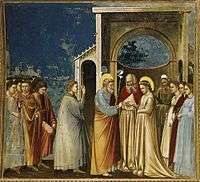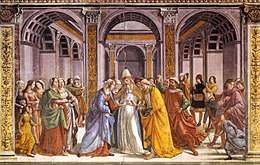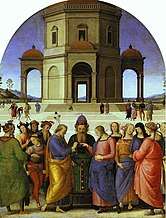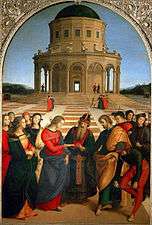Espousals of the Blessed Virgin Mary
The Espousals of the Blessed Virgin Mary or Marriage of the Virgin Mary is a feast that is celebrated in certain parts of the Roman Catholic Church among certain congregations such as the Oblates of St. Joseph. It was removed from many local calendars by the Sacred Congregation of Rites. It was formerly generally observed on January 23.
History
In Matthew 1:16, Joseph is described as the husband of Mary. It is probable that Joseph and Mary were betrothed at Nazareth.[1] The term "betrothal" indicates more than an engagement. It was customary to celebrate marriage in two stages, the first that of the contractual arrangements culminating in consent or "betrothal". After a period of perhaps one year in which preparations were made to establish a new home together, the second stage of actually conveying the wife to that home would be accompanied by a great feast such as that recounted in the Gospel of John as the Marriage Feast at Cana (Jn 2:1-11).[2]
Feast day
The first definite knowledge of a feast in honour of the espousals of Mary dates from August 29, 1517, when with nine other Masses in honour of Mary, it was granted by Leo X to the Nuns of the Annunciation, founded by Saint Jeanne de Valois.[3] In certain particular churches the espousals of the Virgin Mary and St. Joseph are honoured with an office on January 23.[4] The Oblates of St. Joseph celebrate January 23 as the feast of “The Holy Spouses Mary and Joseph”.[5]
Gaspar Bertoni, founder of the Stigmatines, chose Mary and Joseph, in the context of their espousals, as patrons of the Congregation of the Sacred Stigmata.[6]
In art
In art the subject could be covered in several different scenes, and the betrothal of Mary, with Joseph's blossoming rod, was often shown, despite its apocryphal origin. Wedding processions are also shown, especially in the Early Medieval period. The scene, or scenes, was a common component in larger cycles of the Life of the Virgin and thus very frequently found, especially in the Middle Ages; it is not found in the typical cycle in a Book of hours however.
The marriage scene has been painted by, among others, Giotto, Perugino, Raphael, Domenico Ghirlandaio (1485–90, at the Tornabuoni Chapel), Bernardo Daddi (now in the Royal Collection), Veronese (in San Polo church, Venice), and Pieter van Lint (1640, Antwerp Cathedral). The subject is depicted in a fresco in the German Chapel at the Shrine of the Holy House in Loretto, Italy;[7] in a sculpture in the left portico of Sagrada Família Basilica in Barcelona, Spain;[8] and in a stained glass window at St. Rita Basilica, Cascia, Italy.[9]
 Giotto, c 1305
Giotto, c 1305 Domenico Ghirlandaio (1485–90, at the Tornabuoni Chapel)
Domenico Ghirlandaio (1485–90, at the Tornabuoni Chapel)

 Betrothal of the Virgin, Rosso Fiorentino, 1523
Betrothal of the Virgin, Rosso Fiorentino, 1523
References
- Souvay, Charles. "St. Joseph." The Catholic Encyclopedia. Vol. 8. New York: Robert Appleton Company, 1910. 7 Aug. 2013
- "Background of Betrothal and Divorce", Oblates of St. Joseph
- Holweck, Frederick. "Espousals of the Blessed Virgin Mary." The Catholic Encyclopedia. Vol. 5. New York: Robert Appleton Company, 1909. 7 Aug. 2013
- Butler, Alban. The Lives of the Fathers, Martyrs and Other Principal Saints, Vol. III
- "A5:Feast of the Espousals", Oblates of St. Joseph
- ""The Holy Spouses Mary and Joseph, our Patrons", Congregation of the Sacred Stigmata". Archived from the original on 2014-03-28. Retrieved 2014-03-26.
- Seitz, Ludovic. "The Matrimony", Shrine of the Holy House, Loretto, Italy
- Gaudi, Antoni. "The Betrothal", Holy Family Basilica, Barcelona, Spain
- Consadori, Silvio. "The Betrothal", St. Rita Basilica, Cascia, Italy
External links
| Wikimedia Commons has media related to Marriage of the Virgin. |
.jpg)